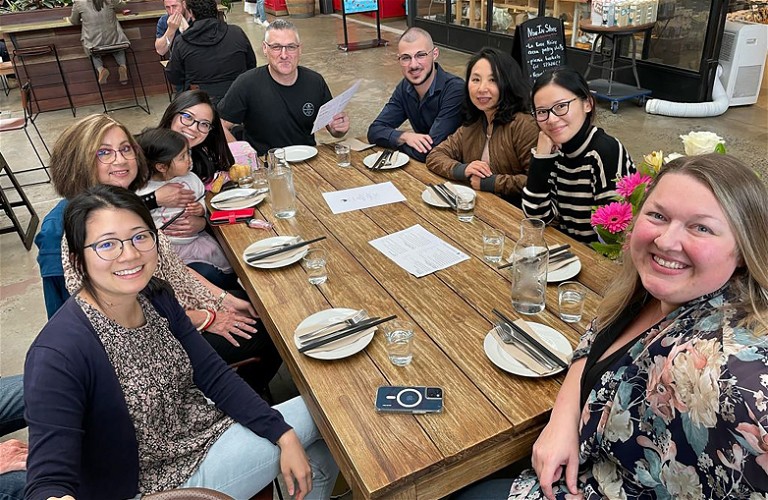mibusiness
Fostering Staff Development and Engagement

What are the keys to attracting and retaining great employees in a highly competitive market? Investing in them while engaging with them, writes Kasia Groves.
WRITER Kasia Groves
The optometry industry in Australia plays a vital role in promoting eye health and providing essential vision care services to the population. Within this dynamic sector, the success and growth of optometry practices rely heavily on the development and engagement of all staff. A motivated and skilled workforce not only enhances the quality of patient care but also contributes to the overall success of the practice.
Here are some strategies and best practices for fostering staff development and engagement in the optometry industry, emphasising the importance of investing in employees’ growth and wellbeing.
A CULTURE OF CONTINUOUS LEARNING
In an industry that is constantly evolving, fostering a culture of continuous learning is crucial. Dr SooJin Nam, an industry leader in children’s vision and myopia control, understands that excellence in optometry extends beyond clinical expertise. Just as she has dedicated herself to advancing children’s vision care, Dr Nam recognises the vital role that a well-trained and committed team plays in delivering exceptional care. “Nothing remains the same and this certainly holds true in an optometry business,” Dr Nam told me. “A business should always be looking to grow, and this should be the same for team members.”
Encouraging staff to engage in professional development programs, attend industry conferences, and pursue further education in optometry and dispensing is crucial. Supporting their participation by providing financial assistance or allocating time off for learning opportunities is invaluable.
It’s also wise to empower staff to share their new knowledge with their team members. This not only enhances their skills and knowledge but also demonstrates your commitment to their growth, and promotes learning opportunities across the organisation.
CLEAR CAREER PATHWAYS
Providing staff with a clear understanding of their career progression within the optometry practice can significantly enhance their engagement. Create opportunities for growth through structured career pathways, allowing employees to set goals, develop new skills, and advance within the organisation.
Regularly discuss their career aspirations and provide guidance and resources on the steps needed to achieve their professional objectives.
REGULAR PERFORMANCE REVIEWS
Performance reviews are invaluable tools for staff development and engagement. Conduct regular reviews to provide constructive feedback on individual performance, identify areas for improvement, and acknowledge achievements.
It is important to have open and honest communication with staff and to approach these discussions with clarity, confidence, and empathy. Create simple, personalised development plans that align with employees’ goals and provide ongoing support and resources to facilitate their growth. “This means taking the time to really get to know your individual staff members and making sure their short- and long-term goals align with what your plans are for the business,” said Dr Nam.
Performance reviews should not only be conducted when an employee has areas to improve in. These meetings are great opportunities for praising and encouraging employees and reflecting with them on their successes, no matter how big or small.
Positive feedback and regular check-ins foster positive relationships and open, honest communication.
MENTORSHIP AND COLLABORATION
Establishing mentorship programs within an optometry practice can foster professional growth and engagement. Pair experienced optometrists with junior staff members to enable knowledge sharing and skill development. As Dr Nam said, “training and personal development is an essential component of employing a staff member. It would be ideal to have a team with a collective growth mindset that encourages one another to continue learning and developing professionally.”
Additionally, promoting collaboration and teamwork among staff members will encourage them to learn from one another, share best practices, and brainstorm strategies for streamlining workflows and processes.
“A team that has a higher sense of purpose and believes in the service they provide, will be the team that elevates each other because they will maintain high standards and expectations of each other. This is the team that will consistently outperform others because their passion will shine,” said Dr Nam.
OPPORTUNITIES FOR SKILL EXPANSION
Offering opportunities for staff to expand their skill sets can boost their engagement and overall job satisfaction.
Allow employees to cross-train in different areas, such as pre-testing, contact lens fitting, paediatric optometry, or specialty eyewear. This not only broadens their expertise but also enhances their sense of value and contribution to the practice.
RECOGNITION AND REWARD
Acknowledging and rewarding staff achievements is essential for fostering engagement and motivation.
Implement recognition programs that celebrate individual and team accomplishments.
This can range from simple gestures, like verbal praise and handwritten notes, to more substantial rewards such as bonuses or additional time off. Regularly show appreciation for the hard work and dedication of your staff.
OPEN TO FEEDBACK
In addition to the strategies mentioned earlier, it is crucial for employers in the optometry industry to recognise the importance of not being afraid to engage with their employees. Open and honest communication is the foundation of a healthy and thriving work environment. By fostering a culture of approachability and active listening, employers can build strong relationships with their staff, creating a sense of trust and mutual respect.
Engaging with employees means being open to feedback and suggestions from all levels of the organisation. Employers should actively seek input from their staff on various aspects of the practice, from operational improvements to patient care strategies. Employees on the front lines often have valuable insights that can lead to innovative solutions and the streamlining of workflows and processes.
Dr Ali Khalife, part-owner and managing optometrist of Eyecare Plus practices in Chullora and Bankstown in Sydney’s southwest, is driven to create an environment that is open and supportive for all staff.
“The most valuable aspect of my business is my staff. They can make or break the business. I have found that creating a work environment where staff can easily provide regular communication and feedback is crucial in maintaining and maximising productivity.
“The staff feel like they are part of the business and that their voices can be heard. This can enhance the collaboration and recognition process,” Dr Khalife said.
Furthermore, employers should not shy away from addressing concerns or challenges that may arise within the workplace. By addressing issues promptly and constructively, employers can demonstrate their commitment to the wellbeing of their employees and the overall success of the practice. Transparent discussions about challenges can lead to collaborative problem solving and a shared sense of ownership over the practice’s outcomes.
CELEBRATE DIVERSITY
Engaging with employees also involves recognising and valuing their unique skills, experiences, and perspectives. Celebrating diversity within the workforce and providing an inclusive work environment can lead to increased job satisfaction as well as a greater sense of belonging among employees. When employees feel their contributions are celebrated, they are more likely to deliver exceptional patient care, contribute to practice growth, and remain loyal to the organisation. “Staffing is the most challenging aspect of operating a private practice. Finding the right people to complement the culture you want to achieve is what we all strive for,” said Dr Nam.
ENGAGE AND INTERACT
Engaging with employees is an integral part of fostering staff development and promoting a thriving optometry practice. By being approachable, actively listening, and valuing employee input, employers can create an environment where employees feel appreciated, heard, and supported.
Employers should actively seek opportunities to interact with their employees outside of formal settings. Whether it’s through teambuilding activities, social gatherings, or simply taking the time for casual conversations, these interactions can strengthen interpersonal relationships and foster a positive work culture. This, in turn, can lead to a workforce that is dedicated to delivering the highest standard of patient care and contributing to the long-term success of the practice.
As the optometry industry continues to evolve, a commitment to investing in employees’ professional growth and wellbeing will set successful practices apart from their competitors. By prioritising staff development, successful optometry practices can not only meet the demands of the ever-changing landscape but also contribute to the advancement and excellence of the industry as a whole.
“ A motivated and skilled workforce not only enhances the quality of patient care but also contributes to the overall success of the practice ”
Staff development and engagement are vital to the success of all businesses, including optometry practices. By cultivating a culture of continuous learning, establishing clear career pathways, conducting regular performance reviews, encouraging mentorship and collaboration, providing skill expansion opportunities, and recognising achievements, optometry practices can nurture a motivated and skilled workforce.
Kasia Groves is the founder of KG2 Consulting (kg2consulting.com.au), providing Human Resources consulting and coaching. Ms Groves is a member of the Australian Human Resources Institute (AHRI) and has over a decade of experience working with small, medium, and large businesses across multiple industries and sectors, including optometry.

Optometrists attending a staff development training day

Kasia Groves